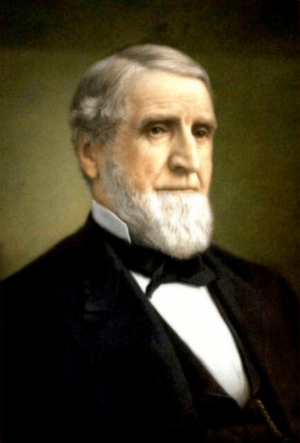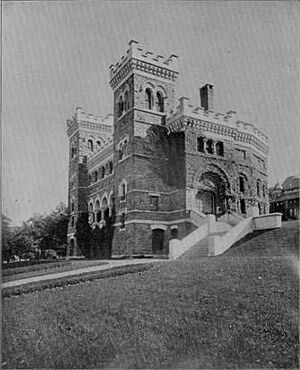Asa Packer facts for kids
Quick facts for kids
Asa Packer
|
|
|---|---|

19th century portrait of Packer
|
|
| Member of Pennsylvania House of Representatives | |
| In office 1842–1843 |
|
| Associate Judge of Carbon County | |
| In office 1843–1844 |
|
| 4th & 6th President of Lehigh Valley Railroad | |
| In office 1868–1879 |
|
| Preceded by | William M. Longstreth |
| Succeeded by | William M. Longstreth |
| In office 1862–1864 |
|
| Preceded by | J. Gillingham Fell |
| Succeeded by | Charles Hartshorne |
| Member of the U.S. House of Representatives from Pennsylvania's 13th district |
|
| In office March 4, 1853 – March 3, 1857 |
|
| Preceded by | James Gamble |
| Succeeded by | William H. Dimmick |
| Personal details | |
| Born | December 29, 1805 Mystic, Connecticut, U.S. |
| Died | May 17, 1879 (aged 73) Philadelphia, Pennsylvania, U.S. |
| Political party | Democratic |
| Spouse | Sarah Minerva Blakslee |
| Occupation | Businessman, railroad executive, politician |
| Signature | |
Asa Packer (December 29, 1805 – May 17, 1879) was an American businessman. He was a pioneer in building railroads. He was also active in Pennsylvania politics. Packer is best known for founding Lehigh University in Bethlehem, Pennsylvania. He was a religious man who believed in traditional values. He served two terms in the United States House of Representatives from 1853 to 1857.
Contents
Early Life
Packer was born in Mystic, Connecticut in 1805. He later moved to Pennsylvania. There, he became a carpenter's apprentice. He worked for his cousin Edward Packer in Brooklyn Township, Pennsylvania. He also worked as a carpenter in New York City. Later, he moved to Springville Township, Pennsylvania. This is where he met his future wife, Sarah Minerva Blakslee.
Career Highlights

Asa Packer and his wife settled on a farm. During the winter, he went to Tunkhannock, Pennsylvania. He used his carpentry skills to build and fix canal boats there. This work continued for 11 years.
In 1833, Packer moved to Mauch Chunk. This town is now called Jim Thorpe, Pennsylvania. He bought a canal boat. This boat carried anthracite coal from Pennsylvania's Coal Region to Philadelphia. He then started a company called A. & R. W. Packer. This company built canal boats and locks for the Lehigh Coal & Navigation Company.
Building Railroads
Packer believed that steam railways were better for carrying coal. He tried to convince the Lehigh Coal & Navigation Company to use them. However, they didn't think it was possible at the time.
In 1851, Packer became the main owner of a railroad company. This company later became the Lehigh Valley Railroad in 1853. They built a railway line from Mauch Chunk to Easton. This line was built between 1852 and 1855. Packer also built railways connecting the main line to coal mines. These mines were in Luzerne and Schuylkill counties. He also planned to extend the line into New York state. This would connect it with the Erie Railroad.
Political Life
Packer was also very involved in politics. From 1842 to 1843, he was a member of the Pennsylvania House of Representatives. He served as a county judge in Carbon County from 1843 to 1844.
He served two terms in the U.S. House of Representatives. He was a Democrat and started his terms in 1853. In 1868, some people wanted him to run for President. He was considered a moderate candidate. However, he did not win the party's nomination.
In 1869, Packer ran for Governor of Pennsylvania. He lost the election by a very small number of votes. It was one of the closest elections in Pennsylvania history.
Founding Lehigh University
Packer wanted to create a university in the Lehigh Valley. This area in eastern Pennsylvania was an industrial region. He decided to build the university on South Mountain. This was in Bethlehem, Pennsylvania.
In 1865, Packer gave $500,000 and 60 acres of land for the school. He later added more land, totaling 115 acres. He wanted to create a technical school for engineers. In 1866, the school was officially started. It was named Lehigh University. The first main building, Packer Hall, was finished in 1869.
Thanks to Packer's generosity, Lehigh University offered free tuition for its first 20 years (1871–1891). Later, money problems in the 1890s made the university start charging tuition.
Packer continued to support the university throughout his life. He also helped manage it. In his will, he left $1,500,000 to the university. He also gave $500,000 to the university library. He left a large part of his estate to the university as well.
Family Life
Asa Packer was married to Sarah Minerva Blakslee (1807–1882). They had seven children together. Their children were Lucy, Catherine, Mary, Malvina, Robert, Gertrude, and Harry.
Death
Asa Packer passed away on May 17, 1879. He was 73 years old. He died in Philadelphia, Pennsylvania.
Legacies

Packer's home, the Asa Packer Mansion, is now a museum. It opened for tours in 1956. It was named a National Historic Landmark in 1985.
Packer was a member of St. Mark's Episcopal Church in Jim Thorpe, Pennsylvania. He gave a lot of money to this church. St. Mark's was also named a National Historic Landmark in 1987. There is an elementary school in Bethlehem, Pennsylvania named after Packer.
Lehigh University still honors him today. There is a large portrait of him by Charles A. Boutelle. They also have an annual Founder's Day celebration. A bronze statue of Packer stands outside Lehigh University's Alumni Memorial Building. It was donated by the Class of 2003. The Lehigh Valley Railroad even named a passenger train after him, called the Asa Packer. This train ran from New York City to Pittston, Pennsylvania until 1959.
See also
- List of railroad executives



